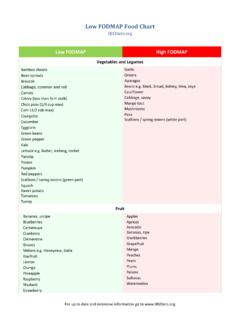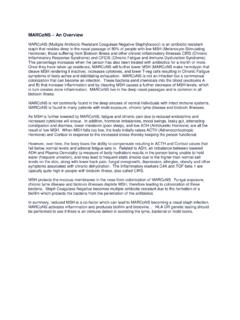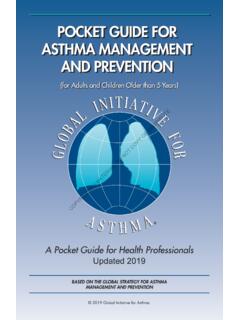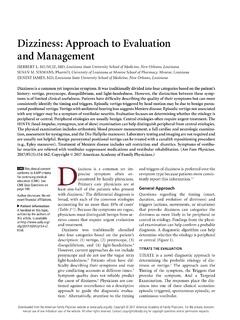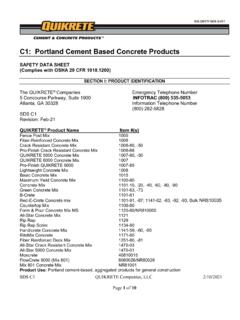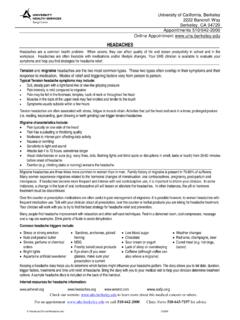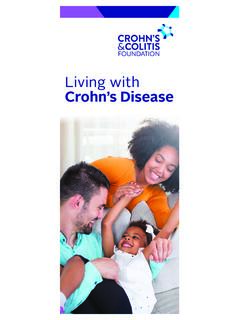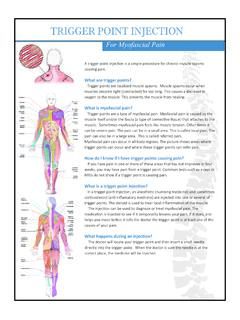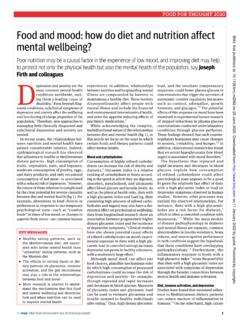Transcription of The Biology and Physiology of Inflammation
1 Functional Medicine University's Functional Diagnostic Medicine Training Program Module 5 * FMDT 541C. The Biology and Physiology of Inflammation By Wayne L. Sodano, , , & Ron Grisanti, , , Limits of Liability & Disclaimer of Warranty We have designed this book to provide information in regard to the subject matter covered. It is made available with the understanding that the authors are not liable for the misconceptions or misuse of information provided. The purpose of this book is to educate. It is not meant to be a comprehensive source for the topic covered, and is not intended as a substitute for medical diagnosis or treatment, or intended as a substitute for medical counseling. Information contained in this book should not be construed as a claim or representation that any treatment, process or interpretation mentioned constitutes a cure, palliative, or ameliorative. The information covered is intended to supplement the practitioner's knowledge of their patient.
2 It should be considered as adjunctive and support to other diagnostic medical procedures. This material contains elements protected under International and Federal Copyright laws and treaties. Any unauthorized reprint or use of this material is prohibited. Functional Medicine University; Functional Diagnostic Medicine Training Program/Insider's Guide Module 5: FDMT 541C: The Biology and Physiology of Inflammation Copyright 2010 Functional Medicine University, All Rights Reserved Functional Medicine University's Functional Diagnostic Medicine Training Program Module 5: FDMT 541C The Biology and Physiology of Inflammation By Wayne L. Sodano, , , & Ron Grisanti, , , Contents The Biology and Physiology of Inflammation 2. Review of Innate and Acquired Immunity 4. Interactions of Cellular and Humoral Immunity as Defense against Invaders 5. An Overview of Inflammatory Disease 6. Triggers of the Immune Response and Inflammation 6. Some of the Pro-Inflammatory Molecules Regulated By NF-kB and Their Physiological Effects 8.
3 Overview of Environmental Stimuli into Biochemical Inflammation 10. Acute Phase Response and Acute Phase Proteins 11. Overview of the Acute Phase Response 12. In Summary 13. References 14. 1. Functional Medicine University's Functional Diagnostic Medicine Training Program Module 5: FDMT 541C The Biology and Physiology of Inflammation By Wayne L. Sodano, , , & Ron Grisanti, , , The Biology and Physiology of Inflammation As you learned in the Immune System module, there is an intimate relationship between the mechanism of Inflammation and the immune system response. Inflammation is the body's normal physiological response to injury. The cause of tissue injury is attributed to trauma, autoimmune, microbial, heat and toxins (chemicals). When tissue injury occurs, numerous substances are released by the injured tissues, which cause changes to the surrounding uninjured tissues. Some of the tissue products that cause the inflammatory reaction include: histamine (which increases permeability, causes contraction of smooth muscle, and constriction of the bronchioles), serotonin, lipid mediators (prostaglandins, leukotrienes, and lipoxins and platelet-activator factor), bradykinin, products of the complement system, products of the blood clotting system, and substances released by the sensitized lymphocytes (lymphokines).
4 These substances are the messengers of the Inflammation process, and have been viewed as areas of therapeutic intervention. Collectively they are called autocoids. Autocoids are substances released from the cells in response to various stimuli to elicit normal physiological responses locally. An imbalance in the synthesis and release of the autocoids contributes significantly to pathological conditions such as Inflammation , allergy, hypersensitivity and ischemia-reperfusion4. General Classifications of Autocoids 1. Biogenic amines histamine, serotonin(5-HT). 2. Biogenic peptides kinins (bradykinin, kallidin), angiotensin 3. Small peptides cytokines ( interleukins, chemokines, lymphokines, interferon, tumor necrosis factor). Cytokines are small soluble proteins with low molecular weight. Their function is to act as chemical messengers for regulation of innate and acquired immunity and stimulate hematopoiesis. They are produced in just about all cells involved with immunity, but in particular the T-helper cells.
5 4. Membrane derived leukotrienes, prostaglandins, thromboxane A2, platelet-activating factor, prostacyclin, lipoxins and hepoxylins 5. Endothelial derived nitric oxide Note: The effects of histamine are mediated through H1 and H2 receptors. H1 receptor activation causes vasodilation, dermal pain, itching, smooth muscle contraction (uterine, bronchial and intestinal), and increased mucous production. H2 receptor activation causes increased gastric acid production, increased mucous production and activation of suppressor T-cells. Platelet activating factor (PAF) is a phospholipid that has messenger functions. It is synthesized by platelets, endothelial cells, basophils, mast cells, neutrophils, monocytes and macrophages from mast cells and platelets. PAF is a mediator of platelet aggregation, Inflammation and anaphylaxis. Note: Inhibition of ACE (angiotensin converting enzyme) with ACE inhibitors will cause a decrease in degradation of bradykinin. One of the adverse side-effect of ACE inhibitors is the development of a dry cough, which can be cause by increased bradykinin levels due to decreased degradation.
6 2. Functional Medicine University's Functional Diagnostic Medicine Training Program Module 5: FDMT 541C The Biology and Physiology of Inflammation By Wayne L. Sodano, , , & Ron Grisanti, , , Inflammation is characterized by the following events: 1. Vasodilatation of the local blood vessels 2. Increased capillary permeability (which causes an increase in interstitial fluid). 3. Clotting of the interstitial fluid (caused by fibrinogen). 4. Migration of monocytes and granulocytes 5. Swelling of the tissues As you can read from the preceding description the inflammatory process is connected to the vasculature. You may recall the cardinal features of Inflammation : tumor, calor, rubor and dolor. The Four Lines of Defense Tissue macrophages are the first line of defense, followed by neutrophil invasion, the second line of defense, and subsequent neutrophilia. A third line of defense occurs with a secondary macrophage invasion into the injured area. The fourth line of defense is the increased production of granulocytes and monocytes by the bone marrow.
7 Activated macrophages produce and release numerous growth factors in the inflamed tissue. The dominant factors (cytokines) released by the macrophages include the following: 1. TNF (tumor necrosis factor). 2. IL-1 (interleukin-1). 3. GM-CSF (granulocyte-monocyte colony-stimulating factor). 4. G-CSF (granulocyte colony-stimulating factor). 5. M-CSF (monocytes colony-stimulating factor). These factors cause an increase in production of granulocytes and monocytes by the bone marrow. These factors also provide a powerful feedback mechanism to help remove the cause of the Inflammation . 3. Functional Medicine University's Functional Diagnostic Medicine Training Program Module 5: FDMT 541C The Biology and Physiology of Inflammation By Wayne L. Sodano, , , & Ron Grisanti, , , LifeART Collection Images Copyright 1989-2001 by Lippincott Williams & Wilkins, Baltimore, MD and Sequoia Education Systems, Inc. Review of Innate and Acquired Immunity You should recall, from the immune system module, the distinction between innate immunity and acquired immunity.
8 Innate immunity consists of the following: 1. Phagocytosis by the tissue macrophage system 2. Stomach acid and digestive enzymes 3. Resistance of the skin 4. Presence of certain substances in the blood (lysozymes, polypeptides, complement, and natural killer lymphocytes). Acquired (adaptive) immunity forms antibodies and activated lymphocytes that attack and destroy specific organisms and toxins. 4. Functional Medicine University's Functional Diagnostic Medicine Training Program Module 5: FDMT 541C The Biology and Physiology of Inflammation By Wayne L. Sodano, , , & Ron Grisanti, , , Interactions of Cellular and Humoral Immunity as Defense Against Invaders Reprinted with permission: Immunosciences Laboratories, Inc. 5. Functional Medicine University's Functional Diagnostic Medicine Training Program Module 5: FDMT 541C The Biology and Physiology of Inflammation By Wayne L. Sodano, , , & Ron Grisanti, , , An Overview of Inflammatory Disease Tissue Injury.
9 Host Defense Mechanism [Immune Response (Innate and Acquired)].. Acquired/Congenital Deficiencies or Defects of the Immune System . Aberration(s) of the Immune Response (Immune system Imbalance).. Chronic Inflammation /Disease (Autoimmune, Cardiovascular, Gastrointestinal, Musculoskeletal, and Cancer). Triggers of the Immune Response and Inflammation There are a host of stimuli that can activate the immune response, and therefore Inflammation . The following is a list of some of the triggers: Oxidative stress (reactive oxygen species, especially oxidized lipids). Radiation Psychological stress Injury Food and environmental allergens Viral infections Nutrient deficient/poor diet ( diet high in refined sugar, SAD diet). Intestinal hyperpermeability (leaky gut). Pathogen-associated molecular patterns (PAMPs) PAMPs are molecules that trigger an immune response by activating toll-like receptors. Toll-like receptors are transmembrane proteins expressed by cells of the innate immune system and the antigen presenting cell.
10 Once activated, the toll-like receptors signal the pathways of the inflammatory response, namely nuclear factor kappa B (NF-kB).[ Note: MAMPs (microbial-associated molecular patterns) is the term sometimes used in conjunction with non- pathogenic microbes]. 6. Functional Medicine University's Functional Diagnostic Medicine Training Program Module 5: FDMT 541C The Biology and Physiology of Inflammation By Wayne L. Sodano, , , & Ron Grisanti, , , The following is a list of some of the PAMPs: lipopolysaccharide (LPS) from the outer membrane of the gram-negative cell wall bacterial lipoproteins and lipopeptides porins in the outer membrane of the gram-negative cell wall peptidoglycan found abundantly in the gram-positive cell wall and to a lesser degree in the gram-negative cell wall lipoteichoic acids found in the gram-positive cell wall lipoarabinomannan found in acid-fast cell walls mannose-rich glycans (short carbohydrate chains with the sugar mannose or fructose as the terminal sugar).
